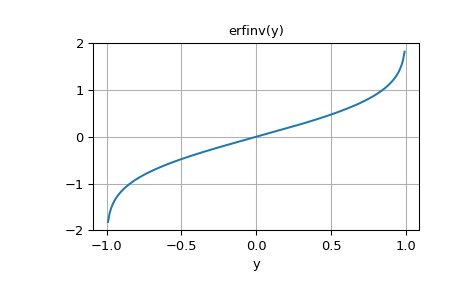erfinv#
- scipy.special.erfinv(y, out=None)#
Inverse of the error function.
Computes the inverse of the error function.
In the complex domain, there is no unique complex number w satisfying erf(w)=z. This indicates a true inverse function would be multivalued. When the domain restricts to the real, -1 < x < 1, there is a unique real number satisfying erf(erfinv(x)) = x.
- Parameters:
- yndarray
Argument at which to evaluate. Domain: [-1, 1]
- outndarray, optional
Optional output array for the function values
- Returns:
- erfinvscalar or ndarray
The inverse of erf of y, element-wise
See also
Notes
This function wraps the
erf_invroutine from the Boost Math C++ library [1].Array API Standard Support
erfinvhas experimental support for Python Array API Standard compatible backends in addition to NumPy. Please consider testing these features by setting an environment variableSCIPY_ARRAY_API=1and providing CuPy, PyTorch, JAX, or Dask arrays as array arguments. The following combinations of backend and device (or other capability) are supported.Library
CPU
GPU
NumPy
✅
n/a
CuPy
n/a
✅
PyTorch
✅
✅
JAX
✅
✅
Dask
✅
n/a
See Support for the array API standard for more information.
References
[1]The Boost Developers. “Boost C++ Libraries”. https://www.boost.org/.
Examples
>>> import numpy as np >>> import matplotlib.pyplot as plt >>> from scipy.special import erfinv, erf
>>> erfinv(0.5) 0.4769362762044699
>>> y = np.linspace(-1.0, 1.0, num=9) >>> x = erfinv(y) >>> x array([ -inf, -0.81341985, -0.47693628, -0.22531206, 0. , 0.22531206, 0.47693628, 0.81341985, inf])
Verify that
erf(erfinv(y))isy.>>> erf(x) array([-1. , -0.75, -0.5 , -0.25, 0. , 0.25, 0.5 , 0.75, 1. ])
Plot the function:
>>> y = np.linspace(-1, 1, 200) >>> fig, ax = plt.subplots() >>> ax.plot(y, erfinv(y)) >>> ax.grid(True) >>> ax.set_xlabel('y') >>> ax.set_title('erfinv(y)') >>> plt.show()
